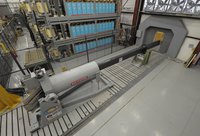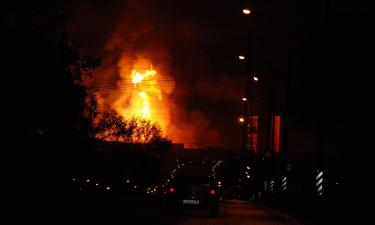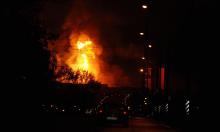Railguns, weapons of future
Are the reserves for the further development of various types of weapons close to being exhausted? Is emergence of new types of weapons with completely different physical principles of action the only way to give it a new impetus? This is true, but the first candidates for the role of weapons of the future already exist. The most promising of them is a "railgun."
Today, writers and futurists like to talk about stagnation of progress. They say that technical history of mankind has stopped its course. Every new discovery requires huge financial investment, hundreds of thousands of man-hours, and the resulting progress is no longer by leaps and bounds, but rather is crawling at a speed of one millimeter per year.
With respect to firearms this statement seems somewhat fair. If we were to mentally place next to each other the Chinese "fiery spear" of the 10th century (a bamboo stick with a tube stuffed with gunpowder and stones) and a modern assault rifle, the progress seems obvious. If we were to mentally place next to each other, say, French kulevrinakh "killer" of the 14th century and "Coalition-SV", all these guns from museums begin to look like a Neanderthal's club.
Yet, if we were to take these weapons apart and see what's inside, it would turn out that over seven centuries of their development the firearms travelled a much shorter path than aviation since the experiments of Bartolomeu de Guzman and the flight of the Montgolfier brothers. There have been no "revolutions" in its history comparable to the emergence of an aircraft. In fact, both ACS "coalition" and "fiery spear" use the same principle. Instead of muscle or mechanical energy, the projectile is thrown at the enemy by means of gas produced in a limited volume in a chemical reaction of auto-oxidation, i.e., combustion of substance that forms the propelling charge. There have been few innovations in this area. They include centuries-old evolution of the system of charging by placing powder directly into the barrel to the unitary charge; the path from the wick inserted into a hole to modern automation providing for 6,000 rounds per minute, and the invention of nitrocellulose and ballistite.

Today, the engineering thought is aimed at addressing three major problems: complete combustion of liners, improvements to active-reactive ammunition and creation of bullets with correctable flight trajectory for handguns. The general principle is exactly the same as it was in the 10th century. The reserves for the further development and modernization are close to being exhausted, and only the emergence of weapons with completely different physical functions can give impetus to the development of new weapons.
The first attempt to walk away from the beaten path was made by none other than Leonardo da Vinci, who proposed to expel a projectile from the barrel by means of steam. Since then, there had been many attempts to invent a steam gun, but each new model lost the competition with the "traditional" solid propellant systems in terms of its ballistic performance, reliability and manufacturing complexity. The fire rate of the most famous example of Russian steam guns - 7-linear (17.5 mm) Karelin gun was impressive by 1829 standards - 50 rounds per minute. Its single copy is now an exhibit in the Artillery Museum in St. Petersburg. Perkins steam gun of the same period that made up to 60 rounds per minute is also a museum exhibit.
The story of weapons that work on the principle of projectile ejected from the barrel by the force of compressed gas is more interesting. Despite the fact that it was used for arming special forces and the navy, the term "pneumatic" is associated mainly with toy, sporting and hunting weapons, but not with the combat. The major obstacle to using pneumatic weapons was an immutable law that became apparent when designing such systems. To reach the ballistic characteristics similar to those of gunpowder, the weight of pneumatic tools must be increased three-fold.
In a nutshell, steam or compressed gas do not fit the role of "weapons of the future" if only because the main principle of the steam guns and pneumatic only mimics gunpowder with other means. The period of rapid development of science and technology in late 19th - early 20th century has spawned an entirely new concept of what is needed to replace the familiar "firearms." Their practical implementation so far has been limited to science fiction writers and creators of computer games. Engineering thought is making cautious steps towards practical implementation of weapons based on new physical principles, and it exists mainly in the form of laboratory facilities. But the "top three" have been defined - it's a laser, Gauss gun, and a railgun, or "mass accelerator."
A "railgun" and "Gauss" are closest to our long-held beliefs about weapons. The target is hit by a material shell instead of "death rays" whose action is limited primarily by the Earth atmosphere, and the fact that the human body is more than 70% water and it is difficult to heat it with a ray.
Electromagnetic weapons capable of throwing a projectile at a speed of nearly nine times greater than the speed of sound provide a number of advantages in comparison with the "traditional" firearms.
"Gauss", despite its apparent simplicity, is hopelessly inferior to a "railgun." Military weapons based on this principle are unlikely to appear at all. Acceleration of a projectile is achieved when a bullet made of electrically conductive material passes through a series of coils generating magnetic field. In the context of a home project that can drive a nail into a darts target from a distance of several meters it looks impressive, but the efficiency is extremely low (2.1 percent).
Even when using a multi-stage acceleration system with sequential switching of coils, only 27 percent of the charge is transferred into kinetic energy (for comparison - in the modern firearms it is 30-35 percent). Rather high consumption of energy coupled with a greater weight of the device and relatively low speed of the booster shell makes the development of a "Gauss" a hopeless case, at least at the current level of technology.
The scheme of rail accelerators gives weapons designers of the future much more advantages over gunpowder, primarily because of the possibility to accelerate ultra-small masses to ultra-high speeds. In general, the scheme looks like this: along two electrodes connected to a power source, a projectile is accelerated by the power of the electromagnetic field, at the same time closing the circuit. The very principle according to which electrical energy is converted into kinetic energy in physics is called the "Lorentz force".
The first patent for a rail gun was obtained by a Frenchman in 1902. The tests were conducted from 1916 to 1918 and were extremely careless. There was no measurement of the current and the initial velocity of the projectile, and as a result only the possibility of developing such weapons was established.
During the next world war the management of the Office of the German Arms became interested in rail guns trophy materials as they frantically grabbed on any project that could play a role of a miracle weapon. Electromagnetic weapons (which included both a rail gun and Gauss) were entrusted to Joachim Hänsler. The tests were carried out in 1944-1945 in a railway tunnel near the town of Klais in Upper Bavaria. The first prototype created by Hänsler's group was a railgun LM-2 that accelerated aluminum cylinder weighing 10 grams to speeds up to 1,080 m /s. For comparison, the best German anti-aircraft gun of the Second World War, 12,8 sm. Flak 40, had an initial velocity of 880 m in m/s.
It is not surprising that the command of the Luftwaffe displayed interest in the results of the tests. They issued Hänsler an order for a rail-aircraft gun capable of firing projectiles containing a pound of explosive with acceleration of 2000 m/s and rate of fire of 10-15 rounds per minute. However, this tool has not been built, and the prototype of LM-2 in 1945 was captured by the Americans. After a new series of tests they issued the following conclusion: the ballistic characteristics are certainly outstanding, but every shot required the amount of power sufficient to lit up half of Chicago.
Nevertheless, the attempts continued. New models of the railgun were developed in the United States, Australia, Britain, the Soviet Union and even in Yugoslavia. The fact that the era of weapons without powder was on the horizon was first mentioned only after December 10, 2010, when the U.S. successfully tested a railgun developed by BAE Systems with a capacity of 33 megajoules with initial velocity of 2,520 m/s. Since then, the prototype shot over ten thousand times (a video is available on Youtube). There are talks about the installation of the first generation of these types of guns on destroyers DDG-1000 Zumwalt.
Velocity of the projectile in the future will increase to 5.8 thousand m/s, fire rate - upto6-15 rounds per minute, and range precision - up to 370 kilometers. The power will be increased to 64 megajoules of energy, and the device will consume at least 16 MW, which is significant even by the standards of ship 72 MW gas turbine generators. In the meantime, a power unit required for producing a railgun shot takes up a small room in the Development Center of the U.S. Navy Dahlgren, where tests are being conducted. Judging by the fact that the program has not yet been brought under the military budget the results were considered significant and the emergence of rail guns in service with the U.S. Navy can be expected in 10-15 years.
In Russia rail weapons are developed by scientists from Shatourskiy branch of the Joint Institute for High Temperatures. They chose a path different from the American one. The creators of the national "rails" decided not to reinvent the wheel and in order to solve the issue of energy supply unit proposed a solution reminiscent of common artillery shells. The role of a cartridge with gunpowder in the "railgun of Artsimovich" is played by a magnetic explosion generator. Its complete combustion creates a powerful electromagnetic pulse required to break the shell with the Lorentz force.
Inside the generator is another gun, this time electro-thermal one, where the shell was originally placed. It is different from the railgun because it does not have a "rail", and acceleration is achieved by means of the pressure created by the instantaneous release of a high-temperature plasma. Videos from the test do not look as colorful as the American ones, however, but are still impressive. A bullet cast of polymer pellet weighing only 2 grams breaks through several targets made of alloy of steel with duralumin set next to each other, leaving huge ragged holes in each of them.
Employees of the Shatura branch suggested using their cartridges separately from the railgun as combat units of anti-aircraft missiles. This would make it possible not only to inflict physical damage to air targets, but also burn all their electronic "stuffing" with an impulse from the detonation explosion generator.
Let's talk about the challenges that the developers of railguns have not addressed yet. The energy sources are not the only issue, and new weapons would require new materials. The notorious Lorentz force at the time of the shot does not only affect the projectile, but also the rails themselves, trying to pull them in different directions. In addition, the accelerating shell expands from heat and when accelerating literally removes layers from the rails.
The parts of the American guns are made of silver plated oxygen-free copper, and after every two or three shots they have to be changed, so the rate of 10-15 rounds per minute can be achieved only in theory. In addition, it is not clear what material would be appropriate for shells given that even the most heat resistant materials at a speed exceeding 7500 m/s are destroyed by the friction with the air, turning into plasma clots. Completely different guidance systems and sights suitable for solving the issue of "hitting a bullet with a bullet" will have to be created. That's plenty of work.
The last question is why is all this necessary? Why spend huge amounts of money to build weapons based on new physical principles if we have powder guns and rifles proven by hundreds of wars for which new "smart" bombs and bullets are being actively developed, capable of reaching the target under nearly any circumstances?
The main advantage of the "rail gun" is its ability to hit a target with a relatively small-caliber projectile at a speed greater than the speed of sound in the material of the target. Another advantage, of course, is the ability to adjust the speed of the projectile, depending on the effect we want to achieve.
For example, when shooting with a "rail gun" at a tank there will be options of penetrating the armor, making a blast on its surface or achieving the force of impact that would turn the projectile into a stream of ionized particles guaranteed to destroy all the electronics, along with the entire crew. The same effect can be achieved when the shooting at sheltered living targets.
It will also be possible to create anti-aircraft guns to take satellites off the low orbit and rail catapults to launch them there. The future is around the corner, all we have to do is solve a dozen of physical and engineering issues.
Alexei Bajkov
Subscribe to Pravda.Ru Telegram channel, Facebook, RSS!




